OPOD - Bird Feather Iridescence
OPOD - Bird Feather Iridescence: A Closer Look at Nature's Colorful Display
Bird feathers have long fascinated us with their vibrant and captivating colors. When a tiny blue tit soars through the sky, its iridescent plumage catches the sunlight, creating a dazzling display of colors. Renowned photographer Rene Winter has mastered the art of capturing these enchanting moments, allowing us to appreciate the beauty of bird feather iridescence up close.
Feathers iridesce in various ways, thanks to their intricate structure. At the core of a feather is the main stem, which branches out into regularly spaced barbs. Each barb, in turn, projects smaller sub-branches called barbules. Even under an electron microscope, these barbules reveal ordered internal structures, adding another layer of complexity to their iridescent properties.
When observing bird feathers close to the sun, caution must be exercised to protect our valuable eyesight. However, it is in these moments that we can witness the effects of light scattering through the arrays of barbs or barbules. These arrays act as diffraction gratings, taking in white sunlight and directing shafts of color in specific directions. Similar to the regular circles of dots on a CD or DVD, adjacent waves of light overlap and interfere, resulting in areas of colored light where wave crests align and darkness where they are out of phase.
Interestingly, scatterers do not necessarily have to be uniformly spaced. The corona around the moon, created by randomly spaced droplets, demonstrates this phenomenon. In the case of bird feathers, individual barbs and barbules can scatter light independently, producing their own unique colors. However, the effect is likely to be weaker compared to the coherent scatter from regularly spaced barbule arrays.
Some birds, such as peacocks, hummingbirds, and certain doves, possess astonishingly vibrant colors through even more sophisticated mechanisms. Within the barbules of these birds' feathers, ordered structures act as three-dimensional photonic crystals, producing structural colors that are truly awe-inspiring.
The intense blues exhibited by kingfishers, parakeets, and blue jays were previously attributed to a different light scattering mechanism known as Tyndall or Raleigh scattering. This mechanism involves the strong scattering of blue light by very small, randomly spaced particles. In fact, our own blue skies are a result of this scattering phenomenon. It was once believed that the material inside barbules acted in a similar manner. However, further research has revealed that the inner structures of these barbules are not entirely random, although they may have initially evolved from random configurations.
While bird feather iridescence is a remarkable display in itself, there are other natural phenomena that exhibit similar optical effects. Subsuns, for example, can be astonishingly bright reflections of the sun created by millions of tiny mirrors. These mirrors are the upper or lower faces of hexagonal plate crystals, which align themselves horizontally due to drag forces. Some larger crystals may wobble slightly from horizontal, resulting in reflections that form sun pillars extending from the subsun up to the sun. Additionally, rays refracted between nearly vertical side faces of the same plate crystals can create sundogs—a beautiful display of colors appearing as bright spots on either side of the sun.
In conclusion, bird feather iridescence is a captivating natural phenomenon that showcases the intricate structures and optical properties of feathers. The arrays of barbs and barbules act as diffraction gratings, scattering and interfering with light to produce a wide range of colors. Additionally, certain bird species employ even more complex mechanisms, such as three-dimensional photonic crystals within their barbules, to create stunning structural colors. As we continue to explore and study these remarkable optical effects, we gain a deeper appreciation for the wonders of nature and the intricate interplay of light and matter.
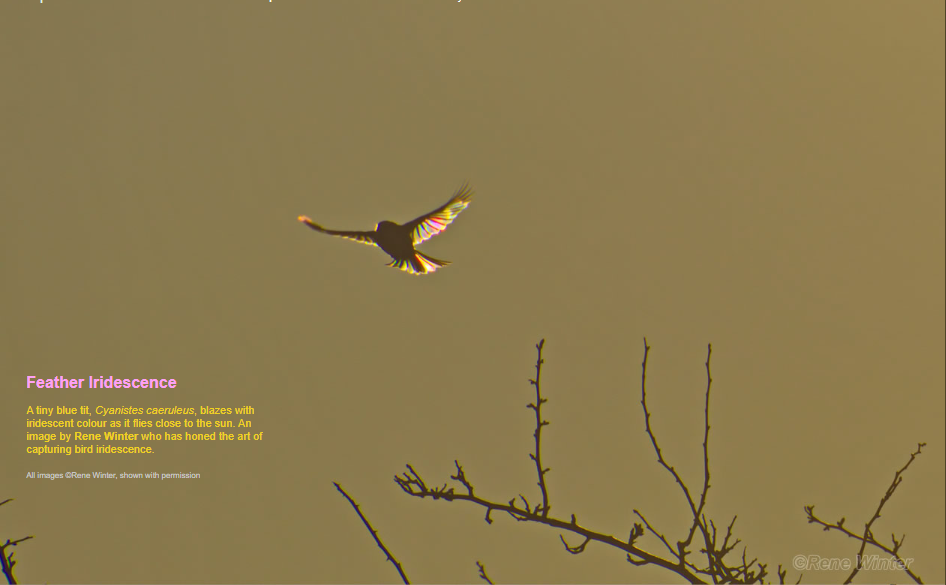
Feather Iridescence
A tiny blue tit, Cyanistes caeruleus, blazes with iridescent colour as it flies close to the sun. An image by Rene Winter who has honed the art of capturing bird iridescence.
All images ©Rene Winter, shown with permission
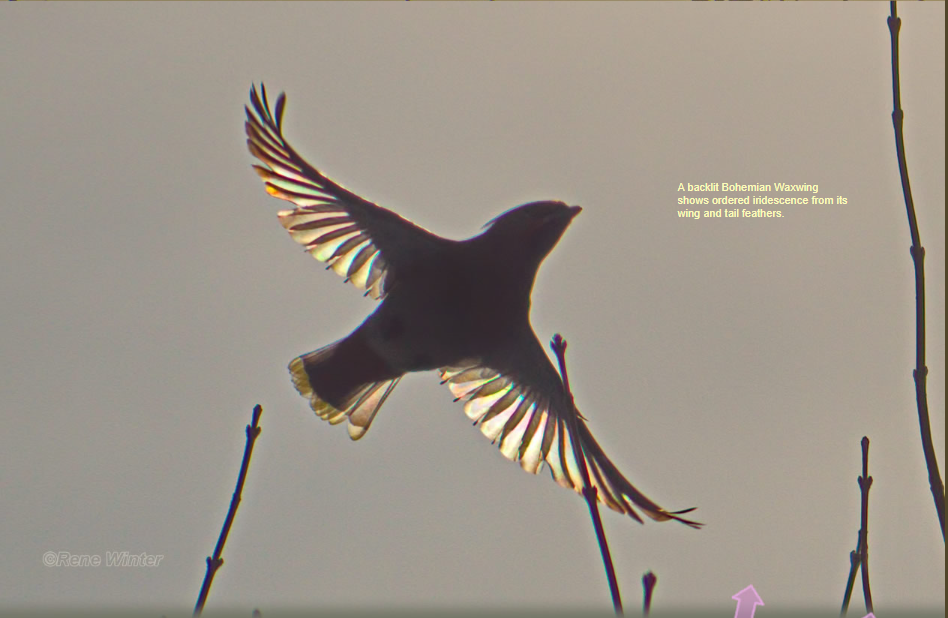
A backlit Bohemian Waxwing shows ordered iridescence from its wing and tail feathers.
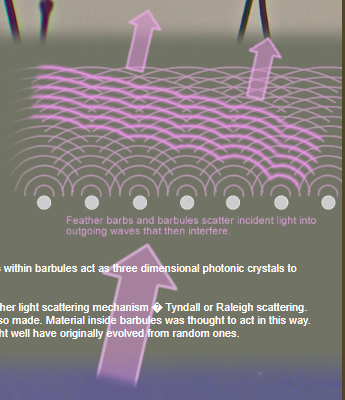
Bird feathers iridesce in several ways. A feather has several levels of order. Its main stem has regularly spaced branches called barbs projecting outwards. In turn, each barb has projecting from it regularly spaced sub-branches called barbules. Look inside the barbules with an electron microscope and they might even have ordered internal structures.
Rene Winter�s images were taken close to the sun. Take extreme care or do not do it! Sight is far too valuable to play with. We are probably seeing the effects of light scattered through relatively small angles by the arrays of barbs or barbules. The arrays act as diffraction gratings taking in white sunlight and directing shafts of colour into specific directions. Each grating element scatters light into outgoing waves. Adjacent waves overlap and interfere. In directions where the sets of wave crests for a particular colour are in phase there is coloured light. Directions where the waves are out of phase are dark. The regular circles of dots on a CD or DVD act the same way.
Scatterers do not have to be regularly spaced � witness those of a corona around the moon from randomly spaced droplets. Feather barbs and barbules can similarly individually scatter light to produce colour. However, the effect is likely to be weaker than the coherent scatter from regular barbule arrays.
Peacocks, humming birds, some doves have bright colours by astoundingly sophisticated mechanisms. Ordered structures within barbules act as three dimensional photonic crystals to produce them � structural colour.
The intense but non iridescent blues of kingfishers, parakeets and blue jays were previously thought to come from yet another light scattering mechanism � Tyndall or Raleigh scattering. Very small randomly spaced particles scatter blue light much more strongly than longer wavelengths � our blue skies are so made. Material inside barbules was thought to act in this way. It is now known that this explanation is over simple and that the inner structures are not quite random � although they might well have originally evolved from random ones.
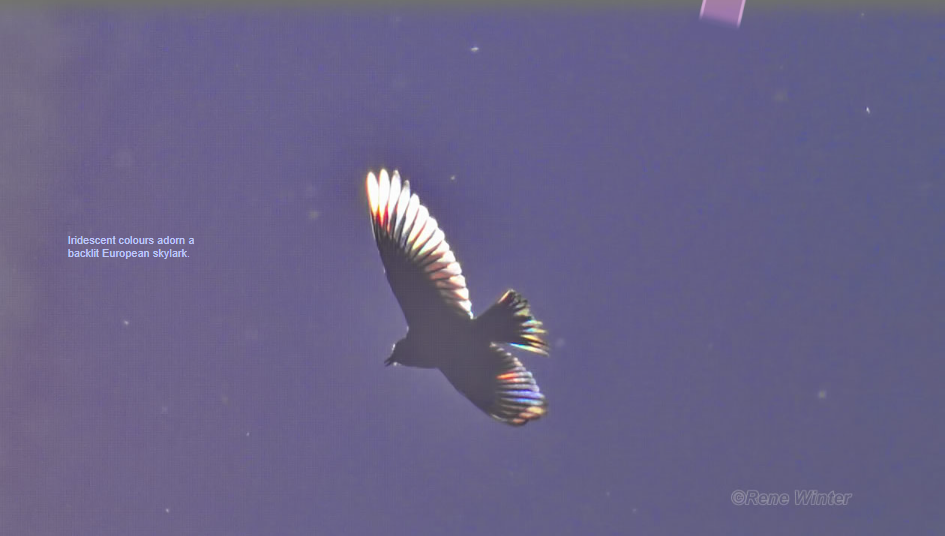

Subsun, Sun Pillar & Sundog
Images by Hamlyn G Jones at Champagny en Vanoise in the French Alps. ©Hamlyn G Jones, shown with permission
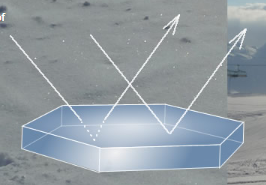

Subsuns can be unbelievably bright. They are a direct reflection of the sun by millions of tiny mirrors. Each mirror is the upper or lower face of an hexagonal plate crystal. The crystals, in this case drifting in the nearby -20 Celsius air, are aligned by drag forces with their large faces nearly horizontal.
Some larger crystals wobble a few degrees from horizontal. Reflections from them form the sun pillar extending from the subsun up to the sun.
Rays refracted between to near vertical side faces of the same plate crystals formed the sundog at lower right. The blue glow lower down is a lens reflection.

Note: this article has been automatically converted from the old site and may not appear as intended. You can find the original article here.
Reference Atmospheric Optics
If you use any of the definitions, information, or data presented on Atmospheric Optics, please copy the link or reference below to properly credit us as the reference source. Thank you!
-
<a href="https://atoptics.co.uk/blog/opod-bird-feather-iridescence/">OPOD - Bird Feather Iridescence</a>
-
"OPOD - Bird Feather Iridescence". Atmospheric Optics. Accessed on November 26, 2024. https://atoptics.co.uk/blog/opod-bird-feather-iridescence/.
-
"OPOD - Bird Feather Iridescence". Atmospheric Optics, https://atoptics.co.uk/blog/opod-bird-feather-iridescence/. Accessed 26 November, 2024
-
OPOD - Bird Feather Iridescence. Atmospheric Optics. Retrieved from https://atoptics.co.uk/blog/opod-bird-feather-iridescence/.